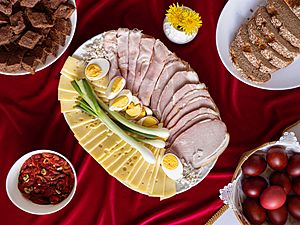Balkan cuisine facts for kids

Balkan cuisine is a delicious mix of food styles from Europe and Western Asia. You can find it in the Balkan Peninsula, a part of Southeast Europe. This region includes countries like Albania, Bulgaria, Romania, Greece, and most of the former Yugoslavia. People from the Balkans have also brought their food to other places. For example, you can find Balkan restaurants in Vienna, Austria, and Germany. Even Romani cuisine, the traditional food of the Romani people, shares many dishes with Balkan cuisine.
Contents
History of Balkan Food
The Balkan region has a long history of different groups ruling and living there. This has created a very diverse food culture. Many different influences have mixed together over time.
Ottoman Empire's Influence
The main foundation of modern Balkan food comes from Ottoman cuisine. The Ottoman Empire ruled much of the Balkans for centuries. Ottoman food itself was greatly shaped by Arabian and medieval Byzantine cuisine. The Ottomans brought new ingredients like peppers to the region. They also introduced dishes such as börek, a tasty pastry made with thin filo dough.
Other popular dishes like ćevapi (small grilled meat rolls) and pljeskavica (a grilled meat patty) also came during the Ottoman period. Even Turkish coffee became a common drink. Interestingly, pork became very popular in northern Serbia. This was because pigs were not taxed under Ottoman Islamic law.
Other Food Influences
Balkan cuisine also uses ideas from the traditional foods of Greece, Persia, Arab countries, and Turkey. There are also influences from Mediterranean cuisine, Armenian cuisine, and Central Europe. You can find similarities with German cuisine, Hungarian cuisine, and Slavic food.
When Austria, Hungary, and Italy were involved in the Balkans, they added their own touches. They introduced dishes like breaded meats and goulash (a stew). They also made seafood more important, especially near the coast. The use of yogurt in meat dishes shows the influence of Persian cuisine. Even Jewish cuisine has contributed, like the sponge cake called patišpanja found in Bosnia and Herzegovina.
What Makes Balkan Food Special?
Balkan cuisine is known for its very diverse, strong, and often spicy flavors.
Common Ingredients and Dishes
- Vegetables: Pickled vegetables and small hot peppers are very common. Peppers are a key ingredient in ajvar, a popular spread.
- Cheese: Feta cheese is another widely used ingredient.
- Stuffed Dishes: Many dishes feature stuffed vegetables. A famous one is sarma, which is made with stuffed vine leaves or cabbage leaves.
- Moussaka: This is a popular dish made with layers of eggplants or potatoes, often with minced meat.
Sauces and Appetizers
Many Balkan dishes are served with kajmak, a thick, creamy dairy product. The egg-and-lemon sauce called avgolemono is also used a lot. Just like in Middle Eastern food, Meze (small dishes) are often served as appetizers.
Desserts and Drinks
Popular sweet treats include baklava (a sweet pastry with nuts and syrup) and halva (a sweet confection). The fruit brandy called rakia is a common alcoholic drink.
Cooking Methods
Cooking is often done using a sač. This is a special baking lid covered with hot coals or ashes. This cooking method has been used since ancient times.
Diversity in Balkan Food
The foods across the Balkan region share many similarities. This is partly because the natural environment provides similar ingredients. Many dishes and recipes have the same names, even if they have small national differences.
Restaurant vs. Home Cooking
You can see the common features of Balkan cuisine most easily in fancy restaurants. However, meals cooked at home show more of the regional differences. There are many unique local variations. A dish with the same name might have different ingredients or be prepared differently in various countries.
Regional Differences
In the North Balkans, chocolate, cakes, and sweet candies are very popular. But in the South, you'll find more seafood, honeyed sweets, and pasta. This shows the stronger Mediterranean influence in the southern parts of the region.
See also
 In Spanish: Gastronomía de los Balcanes para niños
In Spanish: Gastronomía de los Balcanes para niños

